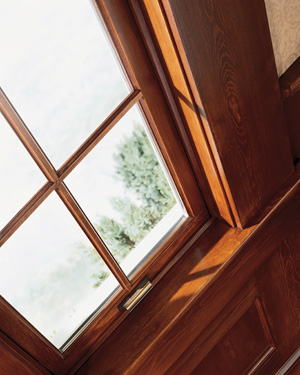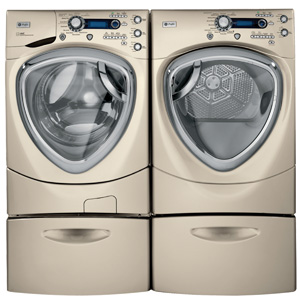Control Moisture
Controlling moisture also is important. But the house needs to breathe to allow excess moisture to escape. Seider recommends controlling this factor with good HVAC (heating, ventilating, and air conditioning) equipment.
Grant also installs a growing number of encapsulated crawl spaces—a method of sealing off the crawl space from the ground and outside air by lining the area with a high-performance vapor barrier. This process not only eliminates moisture, mold, and mildew, but also improves energy efficiency by helping to maintain a constant temperature inside the house.
Orient Your Home Properly on Its Site
Another crucial factor in the energy performance of a log home is site orientation and window placement, experts say. Position the home so that you can take advantage of solar gain to help heat the house in the cooler months—typically with the large portions of glass facing south. That will reduce the demand on your furnace or heat pump, saving energy costs. You can reduce solar gain in the summer, when the sun’s rays are stronger and higher in the sky, by incorporating large overhangs.
Additionally, be strategic about which trees to preserve when clearing the lot for construction. Evergreens on the northern or western sides of the site, for example, make an ideal barrier against the cold and wind. On the other hand, deciduous trees along the southern or eastern sides may provide shade in the summer. Their bare branches in the winter will still let in plenty of sunlight for solar gain.
Select High-Performance

By selecting high-performance window and door products, you’ll see energy savings add up over time. A wide variety of products is available, including argon-filled insulated windows and windows with a low-emission (low-E) film coating that helps to reflect UV rays from the sun. This coating will protect your house from the heat as well as prevent furniture and carpets from fading. Clad windows, available in many styles and color options, also enhance efficiency while reducing maintenance costs.
Stacy Einck-Eckberg, brand public relations and social media manager at Andersen Corp., recommends that homeowners check the window’s overall score from the National Fenestration Rating Council. This independent, non-profit organization examines the overall performance of products from participating manufacturers, evaluating factors such as solar heat gain, UV penetration, and how the frame interacts with the glass.
“The best thing to look for is an NFRC rating that is acceptable for where you live,” Einck-Eckberg says. In a hotter climate like the Southwest, for example, customers may prefer windows with higher UV protection to reduce the amount of sun getting into the house. On the other hand, someone living in a northern climate might prefer a little more solar gain and choose lower UV protection.
“There are lots of options, and where you’re building will determine what type of glass is best for the climate and what window will work best in their application,” Einck-Eckberg adds. “In the case of log homes, lots of windows will fit in that kind of environment, and homeowners should look at all of the options available.”
A wide selection of custom doors and windows—available in a variety of styles and sizes—that look beautiful and perform well are available. Homeowners can work with their designer or builder to select the option that best fits their needs.
Install the Right HVAC Systems
According to EnergyStar.gov, nearly half of your home’s energy costs are attributed to heating and cooling. That’s why it’s important to work with a knowledgeable contractor who can help you select (and properly install) the right system for the climate you live in and the size of your home. Whether you decide to select a heat pump, a furnace or other product, many experts recommend selecting Energy Star®-certified systems or high SEER (seasonal energy efficiency ratio) rated units, as these designations indicate that the products are high-performing and use less energy. Be sure to seal the ductwork to help the units run more efficiently as well.
Don’t forget to keep your HVAC equipment properly maintained. Replace your air filters regularly—especially during the winter and summer months when the units work hardest—and have them inspected annually. Also, install a programmable thermostat if you are out of your house for predictable periods of time throughout the week. That means you won’t have to remember to change temperature settings when you leave, and you’ll save energy costs over the long term.
Also consider improving indoor air quality by installing a HEPA (high-efficiency particulate air) filter, which removes nearly 99.97 percent of pollutants that your equipment’s standard filters cannot touch.
Install Ceiling Fans
The use of ceiling fans, particularly in common areas such as the great room, can help reduce the energy requirements on your heating and cooling systems. Ceiling fans help to circulate the warm air in the winter, while keeping the house cooler in summer months. These are available in Energy Star®-rated models, which the NAHB Log Homes Council estimates are 50 percent more efficient than standard models. During the summer, set the ceiling fan to operate in a counter-clockwise direction to circulate cooler air. In the winter months, reverse the fan to operate in the clockwise direction to create a slight updraft that will pull warm air that rises to the ceiling down into the room.

Install Water Systems
Barna’s Grant often recommends that his clients install tankless hot water heaters, also known as “hot water on demand.” These units eliminate the need for a holding tank that keeps gallons of water hot all the time and provide hot water only as needed. When the homeowner turns on the hot water faucet, cold water is sent into the unit through a pipe. Inside the unit, it is heated by gas or electric power.
“We put them in 8,500-square-foot homes or in 800-square-foot homes,” Grant says. “You can size them as you need, and they’re easy to install.”
Other options for conserving water include low-flow toilets and rainwater management systems.
Select Energy and Water Saving Appliances and Lighting
When it comes to selecting appliances for your log home, Grant says to keep in mind that refrigerators and dishwashers have the highest impact on energy efficiency. For his clients, he recommends Energy Star® appliances. The NAHB Log Homes Council reports that the advanced technologies used to build these products equal energy and water savings of anywhere between 10 to 50 percent over standard models.
As for lighting, compact fluorescent lights (CFLs) are currently in vogue. According to the Log Homes Council, CFLs may reduce energy costs by 70 percent. Another option are LED lights, which Bertrand says are even more energy efficient. “They’re a little pricier now, but with supply and demand, they’ll eventually come down in price,” he predicts. “The full life cycle of LED lights has a better story than CFLs.”’
By installing automatic lighting controls on both interior and exterior lighting, homeowners also may save energy. These devices, which can control certain rooms or the entire house, may be operated from a single switch in the house—at the door leading to the garage, for example—or remotely from smart phones or other devices.
Check into Pricing Incentives
With a stronger national movement for incorporating energy-efficient products into homes, some products may qualify for federal or state tax credits or other incentives, such as manufacturer rebates or discounts from utility providers. Though the largest tax credits have expired, there are still incentives available. You may research these options online at sites such as www.energystar.org, with your local utility provider, or with your log home producer.
